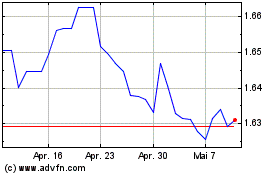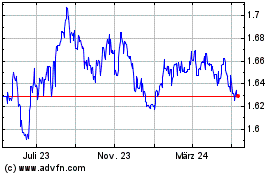Euro Drops After Eurozone Services PMI
05 Dezember 2017 - 6:54AM
RTTF2
The euro weakened against its major counterparts in the European
session on Tuesday, trimming early gains, after a data showed that
German services activity slowed more-than-estimated in November,
while Eurozone PMI matched preliminary reading. Final data from IHS
Markit showed that Eurozone private sector growth accelerated as
estimated in November.
The composite output index rose to 57.5 from 56.0 in October.
The score was unchanged from the earlier flash estimate.
The services Purchasing Managers' Index came in at 56.2, in line
with flash estimate, versus 55.0 in October.
Germany's composite output index improved to 57.3 from 56.6 in
October but below the flash reading of 57.6. At the same time, the
services PMI fell more-than-estimated to 54.3 from 54.7 a month
ago. The initial reading was 54.9.
Meanwhile, European stocks were trading mixed as investors
monitored currency movements and looked ahead to further progress
in Brexit talks and U.S. tax reform.
The currency has been trading in a positive territory in the
Asian session.
The euro dropped to 1.1842 against the greenback, from a high of
1.1877 hit at 9:30 pm ET. The euro is likely to locate support
around the 1.17 region.
The single currency retreated to 1.1673 against the franc, after
having advanced to a 4-day high of 1.1704 at 3:00 am ET. On the
downside, 1.15 is possibly seen as the next support for the euro.
The euro weakened to a 4-day low of 133.23 against the yen,
compared to 133.36 hit late New York Monday. Continuation of the
euro's downtrend may see it challenging support around the 132.00
mark.
The latest survey from Nikkei showed that Japan's services
sector continued to expand in November, albeit at a slower pace,
with a PMI score of 51.2.
That's down from the 26-month high of 53.4 in October, although
it remains well above the boom-or-bust line of 50 that separates
expansion from contraction.
The single currency slid to near 2-week lows of 1.5494 against
the aussie and 1.4995 against the loonie, from yesterday's closing
values of 1.5614 and 1.5035, respectively. Further downtrend may
take the euro to support levels of around 1.53 against the aussie
and 1.49 against the loonie.
On the flip side, the euro hit a 6-day high of 0.8868 against
the pound and held steady thereafter. The pair finished Monday's
trading at 0.8801.
Survey data from IHS Markit showed that British service sector
activity logged a further solid expansion in November, though the
rate of growth eased since October.
The IHS Markit/Chartered Institute of Procurement & Supply
Purchasing Managers' Index, dropped to 53.8 in November from 55.6
in October. Economists had expected the index to drop to 55.0.
Looking ahead, U.S. and Canadian trade data for October, ISM
non-manufacturing composite index and Markit's U.S services PMI for
November are slated for release in the New York session.
Euro vs AUD (FX:EURAUD)
Forex Chart
Von Mär 2024 bis Apr 2024

Euro vs AUD (FX:EURAUD)
Forex Chart
Von Apr 2023 bis Apr 2024
